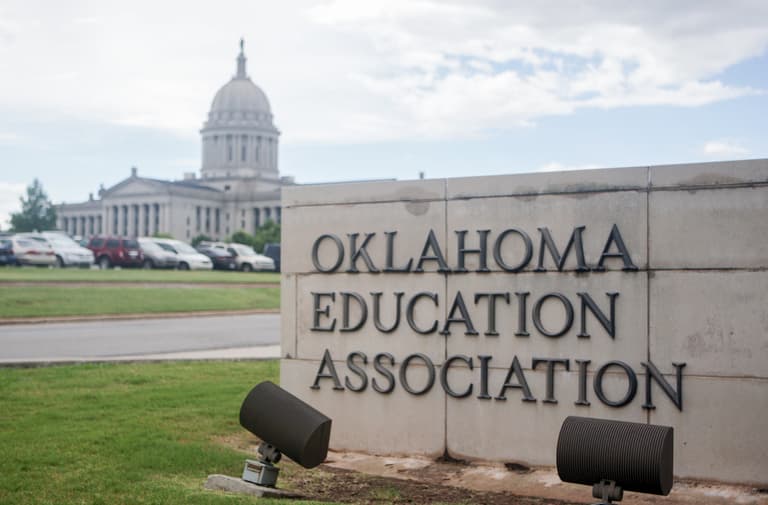
Education
Greg Forster, Ph.D. | January 8, 2019
Collective bargaining not worth it for teachers
Greg Forster, Ph.D.
Oklahoma should follow the example of other states that are moving away from collective bargaining in K-12 education. You’ve heard all the arguments that teacher unions are a special interest that profits from education policies that hurt kids. Those arguments are right—but teachers have also been hurt by collective bargaining.
I’m not against unions. My wife worked for a union for years, volunteering long hours as an employee advocate in company dispute resolution. She signed up to work for the union when she saw managers mistreating workers, and the company violating its contractual obligations to them. The union was the only effective protection those workers had.
“Collective bargaining isn’t a good fit for K-12 teachers. Not all types of workers are well-served by unionizing.” —Greg Forster
But collective bargaining and representation simply isn’t a good fit for K-12 teachers. Not all types of workers are well-served by unionizing. Doctors and lawyers don’t unionize. The nature of the work they do just doesn’t permit the standardization, controlled processes, and highly specified work outputs that are necessary for collective bargaining to be effective.
Teachers are like doctors and lawyers. Standardizing the work they do into a one-size-fits-all mold creates major headaches for them. But collective bargaining demands standardization, so processes and outputs can be specified in labor-management negotiations.
The standardization demanded by collective bargaining is a major factor in all the complaints we’re accustomed to hearing from public-school teachers—useless paperwork, unreasonable rules, rigid systems, dysfunctional bureaucracy. In a 2009 study of national data from the U.S. Department of Education, I compared public and private school teachers. Even before Common Core, the difference in teacher working conditions in schools with and without collective bargaining was dramatic.
Private school teachers, unhindered by the standardization of collective bargaining, were much more likely to have a great deal of control over selection of textbooks and instructional materials (53% v. 32%); content, topics, and skills to be taught (60% v. 36%); performance standards for students (40% v. 18%), curriculum (47% v. 22%) and discipline policy (25% v. 13%). Private school teachers were also less likely to report that various categories of student misbehavior disrupted their classes, and four times less likely to say student violence is a problem on at least a monthly basis (12% v. 48%).
It’s true that collective bargaining brings a moderate increase in pay. The Oklahoma State Department of Education reports that in 2016-17, the average high school teacher made $39,319 and the average elementary school teacher made $37,851. (This was before the $6,100 average pay raise teachers got last year.) In the same year, according to the Oklahoma Private School Accreditation Commission, the average private school teacher salary across all grades was $36,947. Similar gaps are typical nationally. While we don’t have state-specific data to compare benefits packages, from national data we know public-school teachers get better benefits. And public-school teachers have impressive job security protections, which are basically unknown in the private-school sector.
Yet private school teachers are more satisfied with their jobs, even including the pay gap, because the benefits of freedom outweigh the benefits of standardization. In my study, I found private-school teachers were much more likely than public-school teachers to agree that they planned to remain teaching as long as they could (62% v. 44%). They were less likely to agree that they only planned to teach until retirement (12% v. 33%), that they would leave teaching immediately if a job with a higher salary were available (12% v. 20%), that teaching “isn’t really worth it” because of the stress and disappointments (6% v. 13%), and that they sometimes feel like teaching is a waste of time (9% v. 17%).
In fact, private school teachers were slightly more likely to be satisfied with their salaries (51% v. 46%) even though their salaries are lower. Teachers do not live by bread alone.
“Collective bargaining for teachers is not an immemorial tradition; it’s a failed experiment.” —Greg Forster
That’s why, for most of the history of public schools, school employees were not unionized. Most states adopted collective bargaining for teachers in the second half of the 20th century. It’s not an immemorial tradition; it’s a failed experiment.
The idea that teachers are worse off because of collective bargaining may seem crazy. That’s mainly because, for generations, we have allowed teacher unions to be the voice of teachers in the public square. We should rethink that—and rethink whether teachers are well served by collective bargaining.
Greg Forster, Ph.D.
Contributor
Greg Forster (Ph.D., Yale University) is a Friedman Fellow with EdChoice. He has conducted numerous empirical studies on education issues, including school choice, accountability testing, graduation rates, student demographics, and special education. The author of nine books and the co-editor of six books, Dr. Forster has also written numerous articles in peer-reviewed academic journals, as well as in popular publications such as The Washington Post, The Wall Street Journal, and the Chronicle of Higher Education.